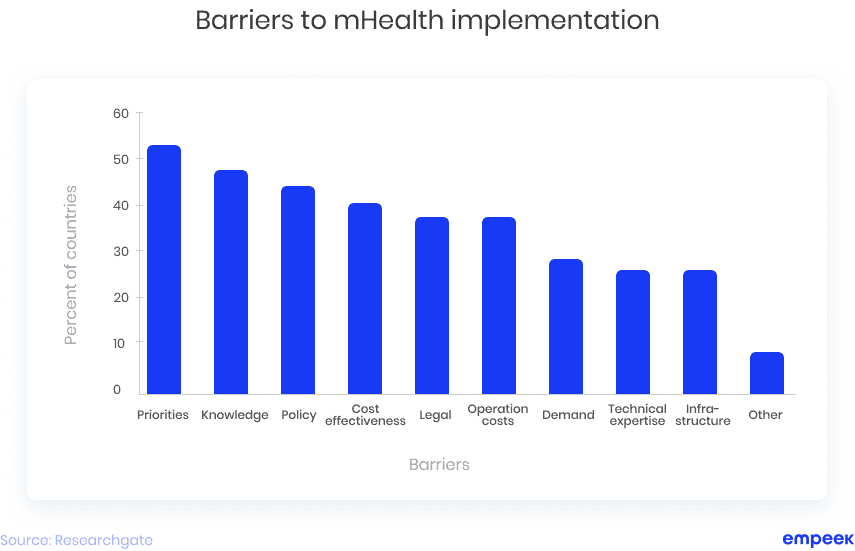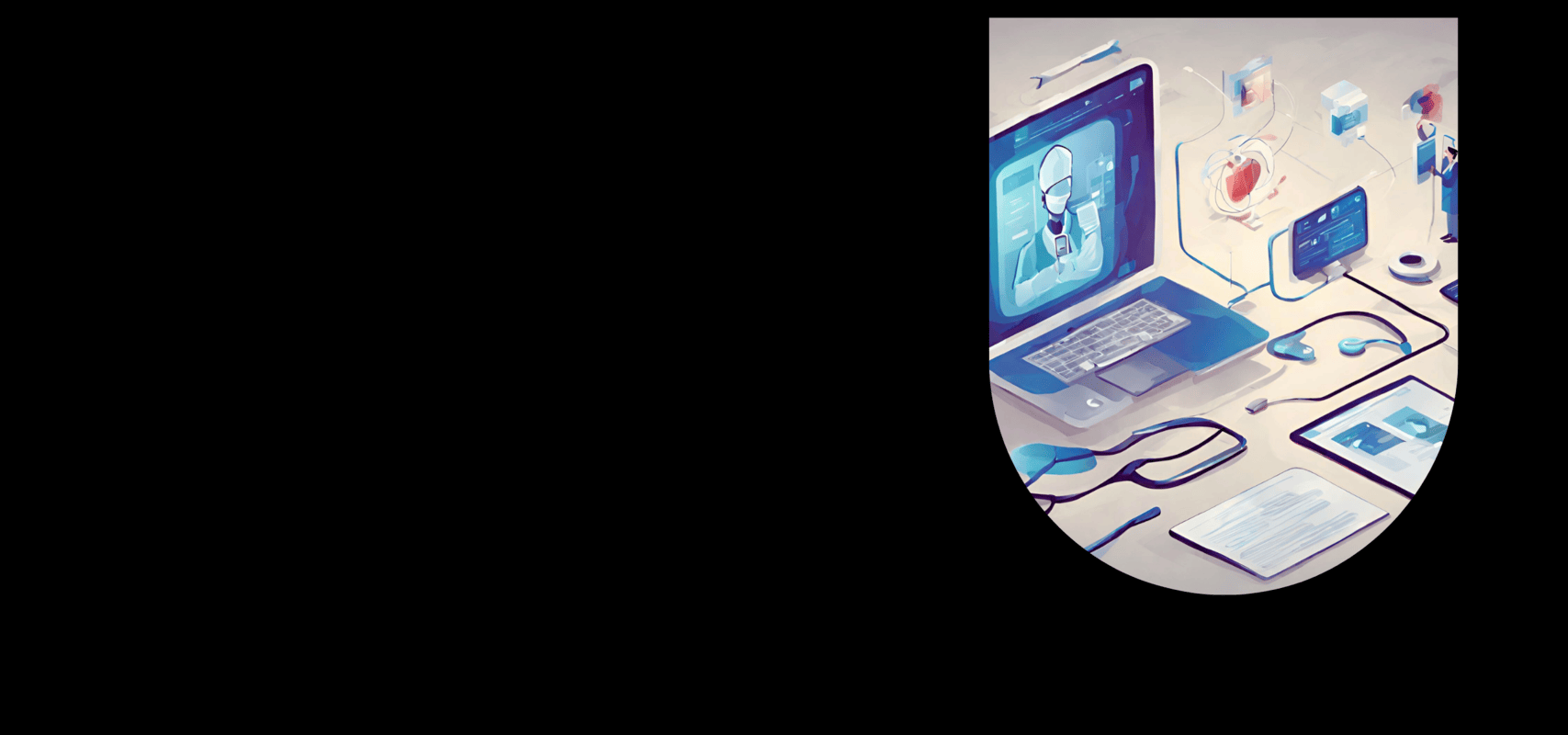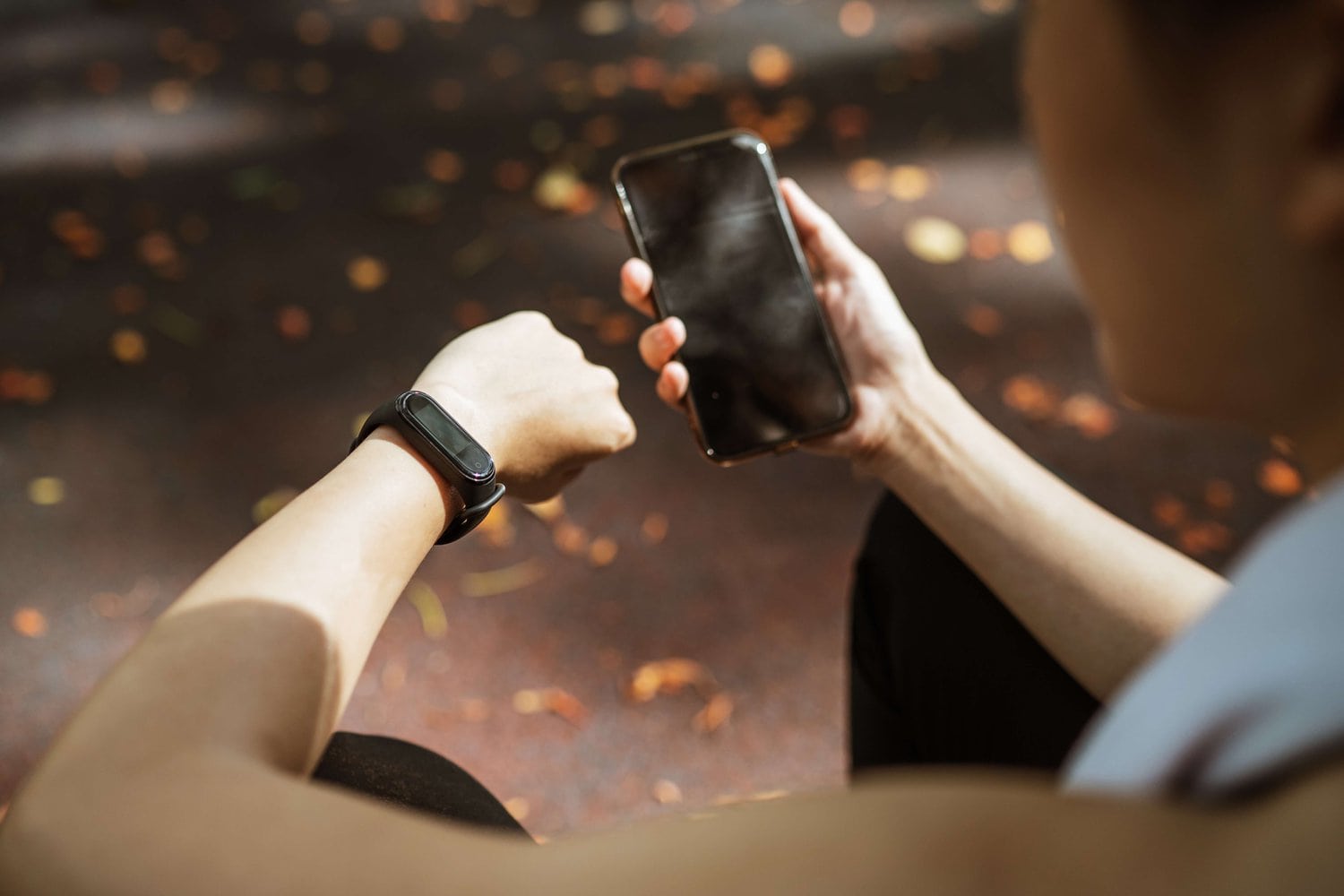It is not a secret that the number of smartphones and tablet PCs is constantly growing. The development of innovative technologies and a relatively low cost of smartphone production allow more individuals to join the cohort of proud smartphone owners. According to the statistics, the number of smartphone users is going to double in a decade (2016-2027) in American states. Couple it with the survey, according to which 58% of the respondents consider the increasing number of smartphones as a key factor to mhealth growth, and the prediction for vast mhealth adoption arises.
For the mainstream acceptance of mhealth technologies to happen, the healthcare sector must overcome barriers to mhealth adoption that emerge in consumers, both healthcare providers and patients. The core issues the healthcare providers experience are changes in organizational structures, the lack of tech skills, and flawed exchange and integration processes along with security and privacy issues. As for the patient adoption of mhealth products, the main issues are low tech literacy and socioeconomic factors.

On the level of a global healthcare system, the main concerns include privacy and ineffective public policies. Issues of data protection and security take fourth place on the list of key factors that influence the mhealth segment. Hence, one of the top mhealth adoption problems is creating an app that is secure and fully integrated into a healthcare system on all levels.
Why knowing the obstacles to mhealth adoption is vital to tech developing companies? The goal of your business is to offer healthcare tech products that solve problems. Knowing why a provider or a patient might refuse to implement your product into their healthcare practices helps you refine the product yet expand the target audience. No one needs a tool that doesn’t satisfy their needs, right?
Most Popular Barriers to mHealth Adoption
All challenges of mhealth adoption can be divided into 3 groups: technical, individual, and healthcare-related. Below you’ll find the examples of all three groups as undercurrent impediments to mhealth adoption.
Security and Privacy
Security is the leading factor to consider during the mhealth app development process. Especially while working on apps that include EHR features. When developing an mhealth tool, one should make sure that a hacker gets no access to the patient data. This might result in broken cryptography and unintended data leakage which are among the top data ‘disasters’ that can happen in the mhealth segment.
How to erase one of the barriers to mhealth patient adoption?
- The app should ask for the user’s consent in case of a data-sharing activity;
- A 2-step verification process or multi-factor authentication is a must;
- The app should be developed in compliance with all healthcare regulations like HIPAA;
- All sensitive data must be encrypted;
- Always conduct security testing to define vulnerabilities before launching the product.
Low Tech Literacy
This problem is popular among the older generation, specifically baby boomers. Ironically, the predecessors of the ‘latch key’ generation constitute 70 million in the United States outnumbered by only 72 million Millennials. Why is this data significant? Unlike Millennials, half of whom visit a doctor once a year, 60% of baby boomers will require constant treatment for chronic diseases in 2030. Fortunately, the boomers own 70% of disposable income, while 54% of the generation is pro-mhealth. Also, 28% of the older population are already using at least one mhealth app.
How can a community solve the low tech literacy problem?
- User-friendly designs have the potential to reduce the remaining barriers like technology anxiety. If your app targets the older population, keep its design as simple as possible;
- Adding a well-detailed introductory video on the app usage;
- Keep in mind that older users might suffer from age-related physical and mental impairment. Adding a speech recognition and voice control feature will be helpful;
- Introducing a 24/7 support team that can help a user with the tool;
- Implementing provider-based short introductory courses online on how to use the app.
Flawed Integration and Low Interoperability
When developing your app, keep in mind that in most cases, it will be a part of the bigger mhealth ecosystem. Sure, if you focus on a fitness or well-being app, you can think of it as a holistic tool. But if you develop a real-time monitoring app as a link between a physician and a patient, you must think of the tool’s interoperability with other systems. What does it mean? Interoperability is all about integrating different systems into one and ensuring smooth and secure data use and exchange. For instance, your app must integrate with the hospital EHR portal. If the tool can’t transfer the data from the patient’s wearables to the hospital station, it is of no use to the healthcare system.
- To keep the whole system unified, ensure robust APIs;
- Create an MVP version so it can be easily tested in healthcare settings. Meanwhile, the user’s feedback will tell you whether the integration is successful or requires refinement;
- Make sure the processes are HIPAA-compliant, while the patient data is safely encrypted;
- Ensure an incident-response system that will notify both a patient and a provider about the tech disaster;
- Ensure the app collects the data offline to prevent connectivity issues and keep all communications intact.
Jumpstart Your Project With Empeek
Get In TouchLack of Trust and Regulation
The lack of regulation coupled with the threat of digital security attacks leads to the user’s distrust in technology regardless of their age. According to the survey, 45% completely trust mhealth ability to keep personal data safe. Meanwhile, 25% of the respondents doubt the mhealth ability to keep their data secure.
The lack of trust results in limited interactivity, meaning that the whole mhealth experience is unsatisfactory. Simply put, a patient might reject the benefits of mhealth yet sabotage the whole treatment process.
How can facilitators increase the user’s trust?
- We advise you to contact the scientific community for a thorough analysis. For instance, if you’ve been developing a mobile mental health app, contact the American Psychiatric Association so they can evaluate the app in clinical settings;
- Use scales like MARS that measure the app’s efficacy, including its design and user engagement;
- Keep your app compliant with the state regulations and emphasize this fact while promoting the tool later.
Consider Empeek Your Trusted Partner
Our company is a team of tech innovators who believe that contributing to global healthcare development is vital. We believe that equal access to high-quality medicine should not be a privilege but a right of everyone. Since the early beginning of our practice, Empeek has been creating advanced customer solutions for healthcare centers all over the world.
One of our recent projects is an app to keep families connected and serve as a cross-platform solution between patients and providers. The app allows the user to receive medication reminders and consult with doctors at any time. Due to a remote backup system, 2-factor authentication, and data encryption, the tool solves security and privacy issues which are among the top mhealth patient adoption barriers. The app effortlessly integrates with EHR systems, adding cost efficiency to the list of the app’s perks.
Another project Empeek specialists focused on is a mental wellness app. It took 18 months to create a tool that would equip the user with necessary stress-relieving and health-monitoring techniques. A part of the mental health program, the app has a reward system and progress tracking among its core features. Meanwhile, the technologies implemented in the app are SQL Server, React Native, and Redux among others.
Got a world-changing idea? Contact our healthcare tech experts!








